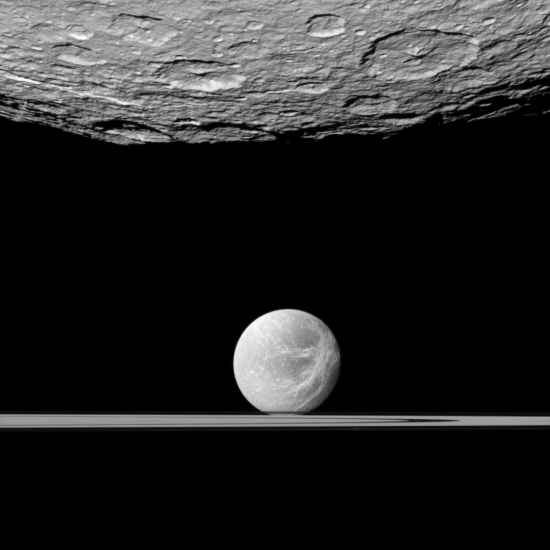Hydrazine on the surface of Saturn’s moon Rhea?
The uncertainty of science: Scientists using data from several Cassini flyby’s of the Saturn moon Rhea now think that hydrazine, a very toxic chemical routinely used by spacecraft as fuel, might exist on its surface.
Their effort was an attempt to identify an unknown spectroscopy absorption feature at a specific wavelength.
In comparison to chloromethane, the production of hydrazine monohydrate was easier to explain due to chemical reactions involving water-ice and ammonia or delivery from Titan’s nitrogen rich atmosphere. Elowitz et al. considered the possibility of contamination of the UVIS data by a hydrazine propellant from the Cassini spacecraft, although it was highly unlikely since the hydrazine thrusters were not used during icy satellite flybys.
The team confirmed the specific signature of a 184-nm feature on Rhea’s surface using the UV spectrometer observations made by the Cassini spacecraft. In addition to that, the irradiation of ammonia by charged particles from Saturn’s magnetosphere induced the dissociation of ammonia molecules to form diazene and hydrazine. The source of ammonia on Rhea could be primordial, incorporated into its interior during formation and brought to the surface within a period of endogenic activity, as evident in Cassini ISS imagery, although ammonia was unlikely to survive indefinitely on the surface. The team suggest further analysis to understand the potential for satellite-to-satellite transfer of materials across Titan’s atmosphere to explain the presence of hydrazine monohydrate on Rhea.
Though useful as a fuel, its poisonous nature will make any exploration of these moons very hazardous, and will also likely make its usefulness difficult initially in that exploration
The uncertainty of science: Scientists using data from several Cassini flyby’s of the Saturn moon Rhea now think that hydrazine, a very toxic chemical routinely used by spacecraft as fuel, might exist on its surface.
Their effort was an attempt to identify an unknown spectroscopy absorption feature at a specific wavelength.
In comparison to chloromethane, the production of hydrazine monohydrate was easier to explain due to chemical reactions involving water-ice and ammonia or delivery from Titan’s nitrogen rich atmosphere. Elowitz et al. considered the possibility of contamination of the UVIS data by a hydrazine propellant from the Cassini spacecraft, although it was highly unlikely since the hydrazine thrusters were not used during icy satellite flybys.
The team confirmed the specific signature of a 184-nm feature on Rhea’s surface using the UV spectrometer observations made by the Cassini spacecraft. In addition to that, the irradiation of ammonia by charged particles from Saturn’s magnetosphere induced the dissociation of ammonia molecules to form diazene and hydrazine. The source of ammonia on Rhea could be primordial, incorporated into its interior during formation and brought to the surface within a period of endogenic activity, as evident in Cassini ISS imagery, although ammonia was unlikely to survive indefinitely on the surface. The team suggest further analysis to understand the potential for satellite-to-satellite transfer of materials across Titan’s atmosphere to explain the presence of hydrazine monohydrate on Rhea.
Though useful as a fuel, its poisonous nature will make any exploration of these moons very hazardous, and will also likely make its usefulness difficult initially in that exploration

